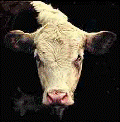Animal Science, Department of

Department of Animal Science: Dissertations, Theses, and Student Research
Date of this Version
2011
Document Type
Thesis
Abstract
Grazing cattle on corn residue as a winter feed source has become an integral part of many Nebraska producers’ management plans. Utilizing corn residues extends the grazing season and is often more economical than grazing winter range or dry lot situations. Corn residue is high in OM and NDF, moderate in digestibility, and low in CP. Cattle grazing corn residues may need to be supplemented with a protein source to meet requirements.
The development and application of DNA technology to create new corn hybrids has improved yields with fewer inputs, leading to a continued low cost food supply for consumers. Previous research has demonstrated the safety of transgenic corn, silage, and corn residue as livestock feed sources. In all trials, transgenic corn is nutritionally similar to non-transgenic corn.
In the current trial, four treatments were applied to a 53 ha center pivot irrigated field of corn. Treatments included a control, light grazing (2.5 AUM/ha), heavy grazing (4.9 AUM/ha), and baling, Samples were collected from all treatment paddocks before and after grazing and analyzed for DM, OM, CP, NDF, IVDMD, and in vitro organic matter digestibility (IVOMD).
Leaf and husk material were consumed in the greatest amount on both grazing treatments. In general, leaf and husk residue had greater CP compared to cob and stem residue. Husk and cob residue had greater NDF content than leaf and stem residue. Digestibility of the residues ranged from 44 to 59%.. Undegradable intake protein digestibility of corn residue is low. Husk and leaf residue UIP digestibility was approximately 23%.
Leaf and husk residue from several transgenic hybrids grown in western Nebraska had greater CP compared to stem and cob residue. Cobs had greater NDF content compared to leaf, husk, and stem residue. Husk and leaf residue from all hybrids had greater digestibility compared to stem and cob residue. A relationship between husk and leaf yield per bushel of grain produced per hybrid was not observed in this trial.


Comments
A THESIS Presented to the Faculty of The Graduate College at the University of Nebraska In Partial Fulfillment of Requirements For the Degree of Master of Science, Major: Animal Science, Under the Supervision of Professors L. Aaron Stalker and Terry J. Klopfenstein. Lincoln, Nebraska: May, 2011
Copyright 2011 Jennifer A. Gigax